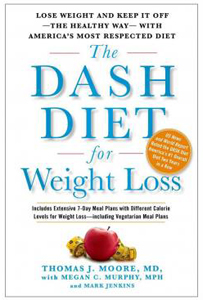By Dani Stone
The DASH Diet for Weight Loss: Lose Weight the Healthy Way – and Keep It Off – With America’s Most Respected Diet is a new diet book written by Thomas J. Moore, MD and Megan C. Murphy, MPH with Mark Jenkins and slated for publication on April 17, 2025. The diet, originally intended to lower blood pressure, prevent diabetes and stop hypertension is now being touted for its comprehensive weight loss approach.
The DASH Diet is based on the DASH (Dietary Approaches to Stop Hypertension) study created in 1993. Dr. Thomas Moore, co-author of the book, gathered in Bethesda, Maryland with a group of 50 researchers, all with one common goal, “design an eating pattern that would lower blood pressure.” After years of research and working with volunteers who agreed to be recipe/meal plan guinea pigs, the results surpassed research goals with volunteers on the DASH diet lowering their systolic blood pressure by at least 11 points, sometimes enough to replace anti-hypertensive medication.
But wait, there’s more! DASH researchers also noted additional benefits including lowering the risk of heart attacks, kidney stones and colon cancer, and it helped people lose weight. U.S. News & World Report agreed, ranking the DASH diet the #1 Overall Diet in 2025. The diet is successful because it encourages counting calories, reducing salt intake and eating fruits, vegetables, whole grains and lean protein.
The DASH Diet for Weight Loss book itself is packed with nutritional information, practical advice and gives readers a step by step guide on how to follow the book for weight loss. At the core of the DASH diet is the “calorie target;” this is the magic number the dieter calculates by using a chart to match weight and activity level with a suggested healthy “calorie intake range.” This range becomes the calorie target. Get your calculators out one more time because then the calorie target is broken down by the number of servings of each food group that should be consumed to make up that number. The book includes a chart for easy reference. For example, according to the chart, a person with a 1200 daily calorie target should have 4 servings of vegetables, 3 servings of fruit, 5 servings of grains, etc.
Exercise is also encouraged in the book with walking recommended as a great start to a new exercise routine, particularly if the dieter is elderly, very overweight or out of shape. Walking is suggested as a, “terrific calorie burning activity” because it, “doesn’t require any special equipment, doesn’t cost anything and you can do it almost anywhere.”
For those who crave meal plans, the book offers several for each specific target with detailed info for each meal and even snacks including serving size and calories.
The diet may not have been created with weight loss in mind, but it has certainly turned out to be a nice perk. Doctors agree the common sense approach is what makes the DASH diet easy to follow and stick to. “DASH is actually awesome. It’s pretty realistic, it’s not bizarre. It just asks people to eat a lot of fruits or vegetables and low-fat or non-fat dairy, which really is how I measure the quality of a diet,” said Dr. Keith Ayoob, director of the nutrition clinic at the Rose F. Kennedy Center at the Albert Einstein College of Medicine.
